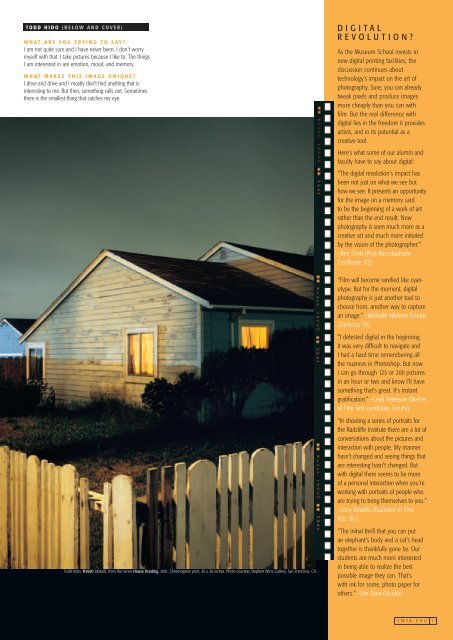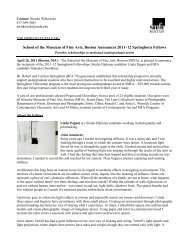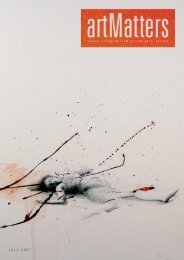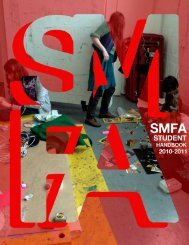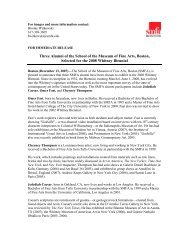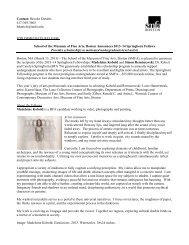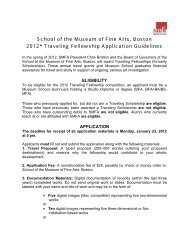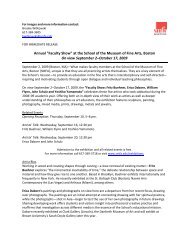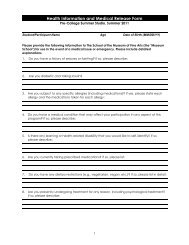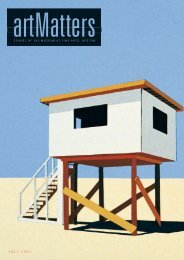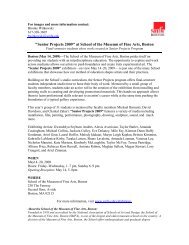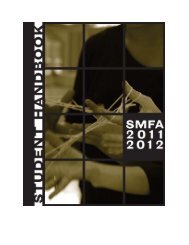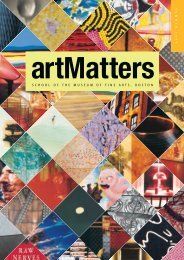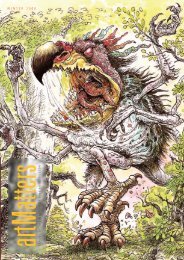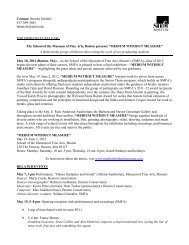S C H O O L O F T H E M U S E U M O F F I N E A R T S , B O S T O N
S C H O O L O F T H E M U S E U M O F F I N E A R T S , B O S T O N
S C H O O L O F T H E M U S E U M O F F I N E A R T S , B O S T O N
Create successful ePaper yourself
Turn your PDF publications into a flip-book with our unique Google optimized e-Paper software.
TODD HIDO (BELOW AND COVER)<br />
WHAT ARE YOU TRYING TO SAY?<br />
I am not quite sure and I have never been. I don't worry<br />
myself with that. I take pictures because I like to. The things<br />
I am interested in are emotion, mood, and memory.<br />
WHAT MAKES THIS IMAGE UNIQUE?<br />
I drive and drive and I mostly don't find anything that is<br />
interesting to me. But then, something calls out. Sometimes<br />
there is the smallest thing that catches my eye.<br />
DIGITAL<br />
REVOLUTION?<br />
As the Museum School invests in<br />
new digital printing facilities, the<br />
discussion continues about<br />
technology’s impact on the art of<br />
photography. Sure, you can already<br />
tweak pixels and produce images<br />
more cheaply than you can with<br />
film. But the real difference with<br />
digital lies in the freedom it provides<br />
artists, and in its potential as a<br />
creative tool.<br />
Here’s what some of our alumni and<br />
faculty have to say about digital:<br />
“The digital revolution’s impact has<br />
been not just on what we see but<br />
how we see. It presents an opportunity<br />
for the image on a memory card<br />
to be the beginning of a work of art<br />
rather than the end result. Now<br />
photography is seen much more as a<br />
creative art and much more initiated<br />
by the vision of the photographer.”<br />
–Ben Sloat (Post-Baccalaureate<br />
Certificate ‘02)<br />
“Film will become rarefied like cyanotype.<br />
But for the moment, digital<br />
photography is just another tool to<br />
choose from, another way to capture<br />
an image.” –Michelle Widmer-Schultz<br />
(Diploma ’01)<br />
“I detested digital in the beginning.<br />
It was very difficult to navigate and<br />
I had a hard time remembering all<br />
the nuances in Photoshop. But now<br />
I can go through 125 or 200 pictures<br />
in an hour or two and know I’ll have<br />
something that’s great. It’s instant<br />
gratification.” –Leah Peterson (Master<br />
of Fine Arts candidate, faculty)<br />
“In shooting a series of portraits for<br />
the Radcliffe Institute there are a lot of<br />
conversations about the pictures and<br />
interaction with people. My manner<br />
hasn’t changed and seeing things that<br />
are interesting hasn’t changed. But<br />
with digital there seems to be more<br />
of a personal interaction when you’re<br />
working with portraits of people who<br />
are trying to bring themselves to you.”<br />
–Tony Rinaldo (Bachelor of Fine<br />
Arts ’81)<br />
Todd Hido, #2690 (detail), from the sereis House Hunting, 2001. Chromogenic print, 30 x 38 inches. Photo courtesy Stephen Wirtz Gallery, San Francisco, CA.<br />
“The initial thrill that you can put<br />
an elephant’s body and a cat’s head<br />
together is thankfully gone by. Our<br />
students are much more interested<br />
in being able to realize the best<br />
possible image they can. That’s<br />
with ink for some, photo paper for<br />
others.” –Jim Dow (faculty)<br />
SMFA.EDU 7


